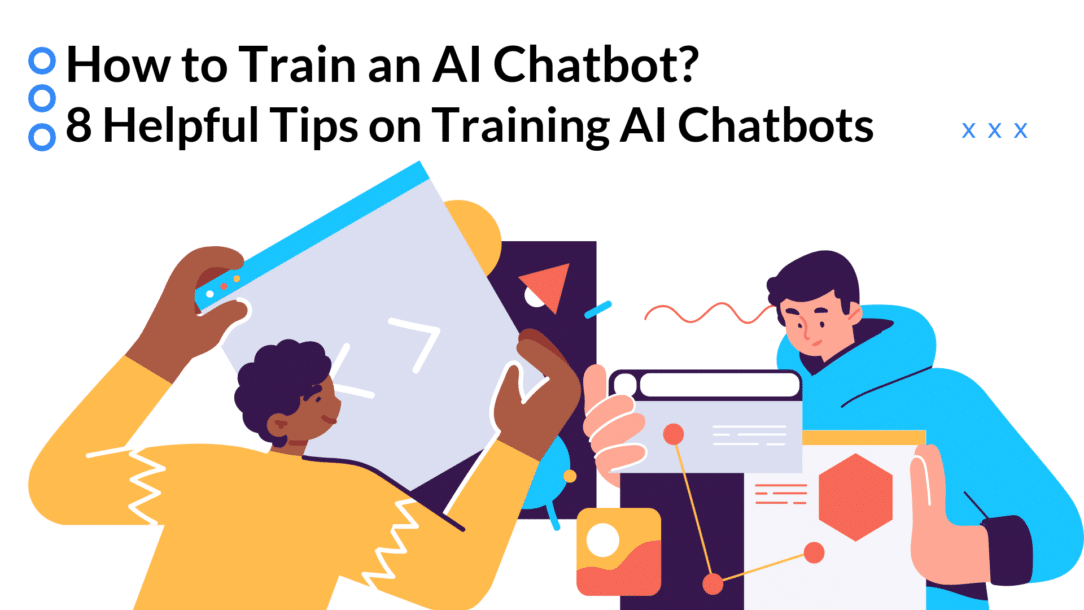Adding a chatbot to your website pages is a great way to address more and more customers as your business grows. With automated computers addressing customers, a chatbot helps solve the growing pain points your company faces. But, how to train an AI chatbot to interact with your audience efficiently?You can train a chatbot using the custom knowledge base through supervised learning and reinforced training.
Moreover, following the steps like determining the chatbot use cases, defining user intent, analyzing customer history, teaching your team members, giving your chatbot a personality, and ensuring that the keyword matches the user intent can also help you train a chatbot and increase customer satisfaction with your website.
Seem difficult? Let’s make it easier!
This guide will discuss a step-by-step guide for training chatbots, how they work, and their launching process on your website.
How Do AI Chatbots Work?
A chatbot is an AI-powered tool whereby an automated computer responds to users’ queries within a chat messaging system. These tools work following their algorithm and natural language processing (NLP) to understand user language and produce responses accordingly. Below is a list of basic chatbot training terms that you should familiarize yourself with.
- Chatbot Training: This involves inputting data into a chatbot to make it understand and respond appropriately to users’ questions
- Intent: The goals, intentions, or purposes behind the user’s questions
- Utterance: The way a user phrases his queries
- Entity: A specific keyword or modifier specifying the user’s intent
- Trigger: The rule that urges chatbots to respond to user questions in certain ways
- Conditions: The requirements that need to be fulfilled for chatbots to produce an action
- Action: The response that chatbots produce after processing a query
In the end, what results is a typical conversion that gives the feel of an instant messaging app. It feels as if the customer is conversing with a human agent on the other end.
Different Ways to Train Artificial Intelligence Chatbots
Advanced developers can train chatbots with the help of sentiment analysis, Python coding language, and Named Entity Recognition (NER). They can also use neural networks and machine learning libraries.
However, if you are not a professional developer, you can use different training approaches and natural language processing.
Your chatbots can learn in two ways: supervised learning and reinforced training.
Supervised Learning
How to train chatbots with a custom knowledge base?
Supervised learning performs best in this regard. In this learning process, the chatbot understands the exact answers to a question based on its database.
Therefore, train a Chabot in this way, and provide it with high-quality questions linked to high-quality answers, so that the chatbot can handle many kinds of customer queries.
Reinforced Training
How to train a chatbot with a custom knowledge base using ChatGPT API?
Use a reinforced training method to train your chatbot using ChatGPT API. In this method, the chatbot experiences trial and error by receiving customer feedback from the responses it produces.
In essence, you enable AI to understand complex behaviors and help it to respond accordingly.
How to Train a Chatbot Using a Bot Platform? Effective Tips You Must Follow
You can craft and train chatbots with code but it takes time and effort. Different frameworks use a variety of automation tools and panels for training your chatbot. But if you are starting from the crash, you can use a platform that offers AI and NLP technology to train your APIs.
Below are some tips that you need to pay attention to when implementing and training bots.
1. Understand What Your Customers Want from Your Chatbot
It is essential to have some data backing up your chatbot instead of just making a wish list of what you would like the bot to do.
Determine what your customers are expecting from your virtual assistant. And for what purpose does your business need conversational AI?
You can check what your shopper want by analyzing their order status. Studies show that 71% of the buyers use a chatbot to check their order status and 67% of them use it for searching products.
2. Define the User’s Intent
You need to comprehend why the visitor is asking the question. What are the intentions and desired outcomes behind their queries?
Understanding this and creating specific chatbot intents helps you deliver purposeful and relevant information to the users when training your chatbot.
For example, you can craft chatbots for customers searching about your opening hours, looking for their order status updates, and searching for products.
Create separate bots for each intent; otherwise, mixing them will deteriorate the user experience.
3. Use Live Chat to Analyze Conversation History
Using the live chat feature is the easiest way to collect and analyze conversations with your clients. Implementing this can help you find common problems that your bot can solve. Common problems can be repetitive questions, tasks, and onboard FAQs.
You can download the conversation history with your clients and analyze it easily using the live chat software.
Pro Tip: Using free training databases for chatbots can help you develop your own natural language processing (NLP) bots from scratch. Some of the best machine learning datasets that you can use include Ubuntu, Twitter library, and ConvAI3.
4. Ensure that Your Keywords or Entities Match the User’s Intent
When you are done writing several utterances, choose the words or phrases that represent key information. These are called entities and they extract relevant information.
This way, you don’t have to tag every word in an utterance. Avoid using single-word utterances like “Barcelona”- these can confuse your chatbot.
5. Create a Professional Team to Train Bots
Your diverse customer support team must know how to train bots. Train them to send automated responses on their own.
Similarly, brainstorming different intents and utterances and testing the bot’s functionality together is a key in chatbot training.
6. Don’t Forget to Give Chatbot a Personality
Your chatbots allow you to connect with potential customers in a way that aligns with your brand. Therefore, finding the right tone of voice, and giving your chatbot a name, and a personality matter the most.
Even if your website uses a professional tone of voice to interact with shoppers, you can still build a chatbot that is fun to engage with.
7. Don’t Rely only on Text – Also Add Media and GIFs
To be engaging with website visitors, you can add media elements along with text when training your bots. You can insert
- GIFs
- Images
- Cards
- Webviews
- Buttons
- Other interactive components
To make the user experience more compelling and interactive. Moreover, product suggestions and Calls-to-action make it easier for website visitors to find and purchase relevant products.
8. Keep Improvising the Chatbots Regularly
Chatbot training is not a set-it-and-forget-it process. Rather it is an ongoing process that needs continuous improvisation. Continuously look at the chatbot analytics and identify where it needs more training.
This gives you important insights into your business and chatbot training process. Sometimes, you might be surprised to see the number of people interacting with your bot.
Thus, don’t stop training your chatbot, as new intents represent new opportunities for learning and training a chatbot.
What Are the Benefits of Training Chatbots?
While business owners can purchase AI chatbots from professional developers, it is crucial to train the chatbot so that it has relevant knowledge to serve your customers.
Training your own AI chatbot comes with many benefits for your company. These include:
- 3.5 times greater customer satisfaction for companies
- Round-the-clock customer support, increasing user experience
- Easy collection of user data and valuable feedback
- Low customer service cost
- Reduced stress on human staff
- Multilingual support across the globe
How Can Clepher Help Businesses Integrate Chatbots?
Clepher, a user-friendly chatbot platform that can be integrated into your website, allows you to create custom responses for FAQs, solve customers’ common issues, gather valuable feedback, and generate leads.
With its advanced AI and machine learning capabilities, your chatbot can provide relevant answers to customer interactions.
Moreover, Clepher’s 24/7 live chat support helps users solve technical issues during the setup process. With a variety of pricing plans, Clepher’s chatbot platform is the perfect solution for your website to flourish. So, try it now and enjoy the results it can generate.
How to Launch a Chatbot on Your Website?
Once you have developed and trained a chatbot from builder software like Clepher, you can easily launch it to your website as a widget. You can customize the appearance and behavior of your chatbot from the menus and make it appear either on every page or tucked into a corner only on certain pages.
With Clepher, installing a chatbot on your website is a snap. Simply head towards the “installation” section, copy the code snippet, and paste it on the page you want it to appear in.
Frequently Asked Questions About Chatbot Training
Can I earn money by training my chatbots?
Yes! Individuals who know how to train chatbots can make money from this profession. According to Reddit, a chatbot trainer can earn up to $18 per hour for writing answers to chatbot prompts.
Do I need skills to train my chatbots?
Chatbot providers like Clepher don’t require specific coding skills. You just need to be familiar with HTML.
The website’s user-friendly interface helps you load one of many templates, so you don’t need to start from scratch.
The Bottom Line: Train AI Chatbot
So, how do you train an AI chatbot?
You can train your chatbot by giving it conversation data so it understands customers’ queries and user intent and has the relevant knowledge to respond to questions.
You can understand and code your customer’s intent, most frequently asked questions, utterances, and more by implementing supervised learning and reinforced learning.
Our platform, Clepher, with its pre-built templates and cutting-edge NLP technology, helps you use chatbots for your business. So, look no further and get started now.
Related Posts



